Paolo Fiammingo
Pauwels Franck known in Italy as Paolo Fiammingo and Paolo Franceschi[1] (c. 1540 - 1596), was a Flemish painter, mainly of landscapes with mythological, allegorical and religious scenes, who was active in Venice for most of his life.[2]
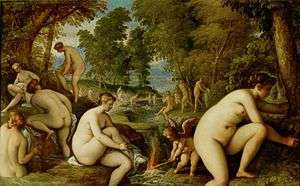
Life
No concrete details about Pauwels Franck's early life and training have been preserved. He was likely born c. 1540. His birthplace is not known. He became a member of the Antwerp Guild of Saint Luke in 1561.
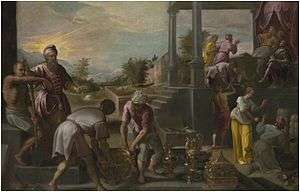
The exact dates and details of his travel to Italy are not known. He is believed to have passed through Florence where he had contact with artists working in the Studiolo of Francesco I de' Medici, Grand Duke of Tuscany.[3] He is recorded in Venice from 1573 but was likely an assistant in Tintoretto’s workshop there already in the 1560s.[4] In Venice he is believed to have been in contact with his fellow countryman Lodewijk Toeput, who was also working in Tintoretto's workshop. The two artists may have met in Tintoretto's workshop.[5]
From 1584 to his death the artist was registered at the painter's guild of Venice. In Italy the artist became known by the name Paolo Fiammingo ('Paul the Fleming'). He resided and worked in Venice for the rest of his career.[2] He opened a successful studio in Venice, which received commissions from all over Europe.[4]
He worked for international patrons including Hans Fugger (1531-1598), the heir of a German banking dynasty. Fugger commissioned him in 1580 to produce several series of paintings to decorate Castle Kirchheim in Württemberg near Augsburg, the Fugger family's summer residence.[6] While Paolo Fiammingo produced a large number of work in the 1580s for the Fugger commissions, he appears to have produced at the same time several versions of many of the compositions made for the Fugger family. This suggests that Paolo ran a workshop of some size at the time.[7]
Work
.jpg)
The artist painted landscapes with religious scenes but is mainly known for his allegorical and mythological scenes. The latter were inspired by Giorgione but were treated by Franck with a Venetian softness and grace and set in dreamlike landscapes. These landscapes anticipate the Italianate Flemish school later associated with Paul Bril and Jan Brueghel the Elder. A good example is the Landscape with the Expulsion of the Harpies (National Gallery London, 1592–6).[4]
The Fugger family gave various commissions to Paolo Fiammingo for the decoration of their new Castle Kirchheim in Württemberg. It is believed that he painted a total of d 37 canvases for the Fuggers. In 2007, 18 of these works were still in possession of the family, 8 in the Bayerische Staatsgemäldesammlungen, Munich, and one painting was in a private collection. Most of these paintings remained united for a long time although some dispersal started to happen from the 17th century.[7] They were photographed at the end of the 19th century. The photos are an important source for understanding the work of Franck.[6] Some of the works formerly in the Fugger collection have appeared recently at auctions.[6][8]
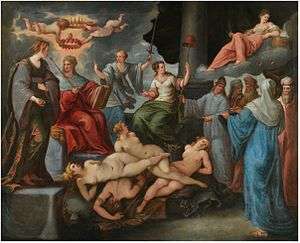
One Fugger commission on which he worked between 1580 and 1592 was a series of twelve works depicting The Four Ages of Man.[2] The iconography of this series was derived from Ovid's Metamorphoses (I:89-150), which recounts how the earthly paradise of the Golden Age descends through the Silver Age and Bronze Age into the strife and greed of the war-like Iron Age.
Another series made for the Fuggers was a set of the Planets in which the seven planets were represented. The series was completed by a composition of the Triumph of the Virtues over the Vices (Sotheby's auction in London on 6 July 2011). In the foreground there are four naked, partly tied female figures lying on sacks and chests, accompanied by a fierce looking dog and cat. This group of vices is surrounded by the personifications of four virtues and five philosophers or holy men. Another female figure with bare breasts resting on a cloud is watching a pot from which smoke is emerging. She is also holding a pair of compasses and a balance. The composition depicts the Triumph of the Virtues over the Vices as a trial of traitors.[8]
A series of allegories of the Four Elements made for the Fuggers are lost but other series and copies of these allegories are still in existence. A full set was sold at Sotheby's on 5 December 2007 lot 17,[7] Another allegorical theme treated by the artist is that of the four seasons. A set is in the collection of the Prado and as is usual with these works, they illustrate the four seasons by depicting the human activities linked to each season.
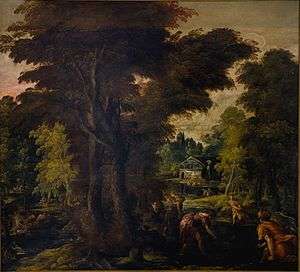
His masterpieces include the four Allegories of Love (Kunsthistorisches Museum Vienna, c. 1585), including the Amore letheo, the Punishment of Love, Reciprocated Love and Love in the Golden Age. These last two works became rapidly known through prints made by Agostino Carracci.[4] It is possible hat Carracci's reproduction of Love in the Golden Age was the inspiration for Matisse's Le bonheur de vivre (Joy of Life).[9]
Landscapes took up a more important part of the artist's activity from 1590 onwards. His landscape compositions combine the Nordic tradition of landscape paintings with Venetian pictorial plots. His brushwork is loose and less descriptive than Flemish landscapes from the same time. His palette is decidedly Venetian, with mainly warm colours, dominated by brown, red and pink. An example is the Landscape with nymphs fishing (Pinacoteca Civica, Vicenza). While the landscape component is prevalent in this composition there is a narrative element with nymphs fishing and figures darting from the foreground to the background. The canvas dates from the later period of the painter's career when he often reflected on the themes of hunting and fishing activities. The theme of the composition may also be an allegory of water. The exuberance of the nature portrayed with great precision shows his Flemish training. The Flemish character is tempered by obvious Venetian influences, and in particular that of Tintoretto, reflected in the perspective view and the sudden movement of protagonists, highlighted by light touches and light strokes.[10]
References
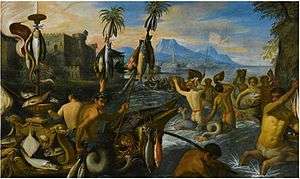
- Other name variations: Paolo dei Franceschi, Paul Franchoys, Pauwels Frank, Frank Pauwels
- Pauwels Franck at the Netherlands Institute for Art History (in Dutch)
- Paolo Fiammingo at the Prado website (in Spanish)
- "Fiammingo, Paolo." Grove Art Online. Oxford Art Online. Oxford University Press. Web. 27 Jul. 2014.
- Anne-Sophie Banner, Les jardins dans l'oeuvre de Lodewijk Toeput: entre tradition flamande et culture vénitienne, Département d’histoire de l’art et d’études cinématographiques, Faculté des arts et des sciences, Mémoire présenté à la Faculté des études supérieures, En vue de l’obtention du grade Maître (M.A.) en histoire de l’art, Décembre 2014, p. 23 (in French)
- Pauwels Franck, called Paolo Fiammingo (Antwerp? c. 1540-1596), The Age of Bronze; and The Age of Iron at Christie's auction in London on 3 December 2008
- Paolo Fiammingo (Antwerp (?) circa 1540 - 1596), The four elements at Sotheby's
- Pauwels Franck, Triumph of the Virtues over the Vices at Sotheby's auction in London on 6 July 2011
- Catherine C. Bock Weiss, Henri Matisse: A Guide to Research, Routledge, 25 February 2014, p. 286
- Pauwels Franck, detto Paolo Fiammingo, Paesaggio con ninfe pescatrici at Pinacoteca Civica, Vicenza site (in Italian)
External links
